The golf grip is often overlooked by beginners, yet it serves as the cornerstone of a successful swing. For right-handed golfers, understanding how to hold a golf club correctly can significantly impact their performance on the course. A proper grip not only influences shot accuracy but also enhances power and consistency. This comprehensive guide will delve into the intricacies of grip for right-handed golfers, exploring various grip types, pressure techniques, hand positioning, and common mistakes to avoid. By mastering the fundamentals of grip, you can unlock your full potential and elevate your game.
Choosing the Right Grip: Understanding Your Hand Size and Grip Type
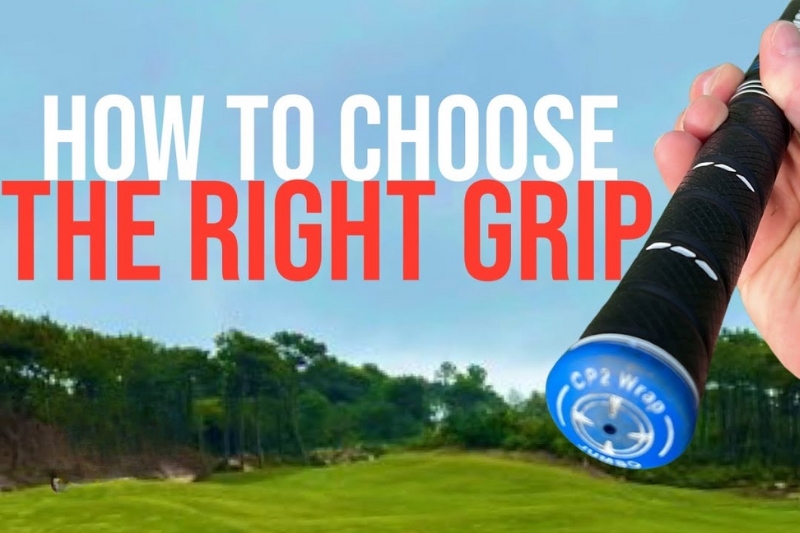
Before diving into specific grip styles, it’s essential to assess your hand size and natural tendencies. The grip you choose should feel comfortable and supportive, allowing you to maintain control over the club throughout your swing.
Hand Size
Understanding your hand size is crucial in selecting the appropriate grip type. Golf grips come in various diameters, and choosing one that fits your hands can make a significant difference in your performance.
Large Hands: If you have large hands, you may benefit from grips with a greater circumference. These grips provide a more secure hold, reducing the likelihood of slipping during your swing. A larger grip can also help prevent excessive tension in your hands and forearms, promoting a smoother swing.
Small Hands: Conversely, golfers with smaller hands might prefer grips with a narrower diameter. A smaller grip allows for better control and reduces strain, enabling you to maintain a relaxed grip throughout your swing. Finding the right fit is essential for maximizing comfort and performance.
Grip Type
There are three primary grip types popular among right-handed golfers, each offering unique advantages and characteristics.
The Vardon Grip: Named after legendary golfer Harry Vardon, this classic grip involves overlapping your pinky finger of your left hand over the index finger of your right hand. It promotes a strong grip, providing solid control and power. Many professional golfers favor this grip due to its stability and effectiveness.
The Interlocking Grip: This grip features the index finger of your right hand interlocking with the middle finger of your left hand. It offers a balance between control and power, making it a popular choice for golfers seeking stability and ease of application. The interlocking grip can be particularly beneficial for players with smaller hands.
The Baseball Grip: As the name suggests, this grip resembles the way you’d hold a baseball bat. Both hands are placed side-by-side, with no overlap or interlocking. It provides a relaxed and intuitive feel, allowing for a more natural swing. This grip is often favored by beginners or those who struggle with other grip types.
Experimentation is Key
Finding the right grip type is a personal journey, and experimentation is essential. Don’t hesitate to try different grip styles to discover which one feels most comfortable and yields the best results for your swing. Consulting with a golf professional can provide personalized guidance and recommendations tailored to your unique needs.
The Vardon Grip: A Classic and Effective Right-Handed Hold
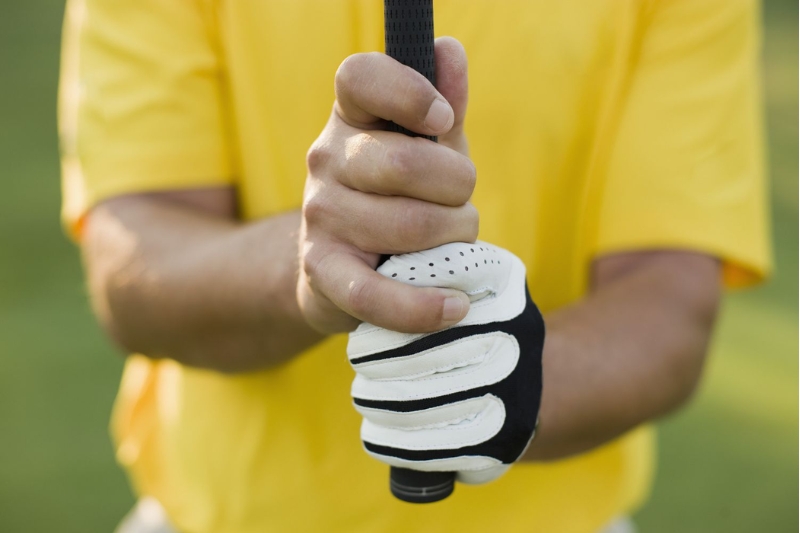
The Vardon grip is widely regarded as the most commonly used grip among professional golfers. Its design offers a strong and stable hold, making it an excellent choice for right-handed players looking to enhance their performance.
Placement
To achieve the Vardon grip, start by placing the grip in the palm of your left hand. Your left thumb should point down the shaft, while the index finger rests along the grip. Next, position your right hand below the left, ensuring that your pinky finger overlaps the index finger of your left hand. This overlapping technique creates a unified grip that enhances control and stability.
Pressure
When gripping the club, aim for a firm but not overly tight hold. Imagine holding a bird in your hand—apply just enough pressure to prevent it from flying away, but not so much that you crush it. Striking the right balance in grip pressure is crucial for maintaining control without introducing unnecessary tension.
Alignment
Proper alignment is vital for achieving optimal results with the Vardon grip. Ensure the clubface is square to the target line, and keep your hands aligned with the target. Your left hand should be slightly higher than your right, creating a natural angle that facilitates a powerful swing.
Advantages
The Vardon grip offers several advantages that contribute to its popularity among golfers:
Control and Stability: The overlap created by the pinky finger promotes a strong grip, providing excellent control and stability during the swing. This stability translates to improved shot accuracy and consistency.
Power Transfer: The Vardon grip allows for smooth power transfer from your body to the clubhead. This efficient transfer of energy enhances clubhead speed, resulting in longer shots.
Accuracy: With a strong grip, golfers can minimize unintended hooks or slices, leading to greater precision in shot placement. The Vardon grip fosters confidence, allowing players to focus on their swing mechanics rather than worrying about grip issues.
The Interlocking Grip: A Popular Choice for Right-Handed Players
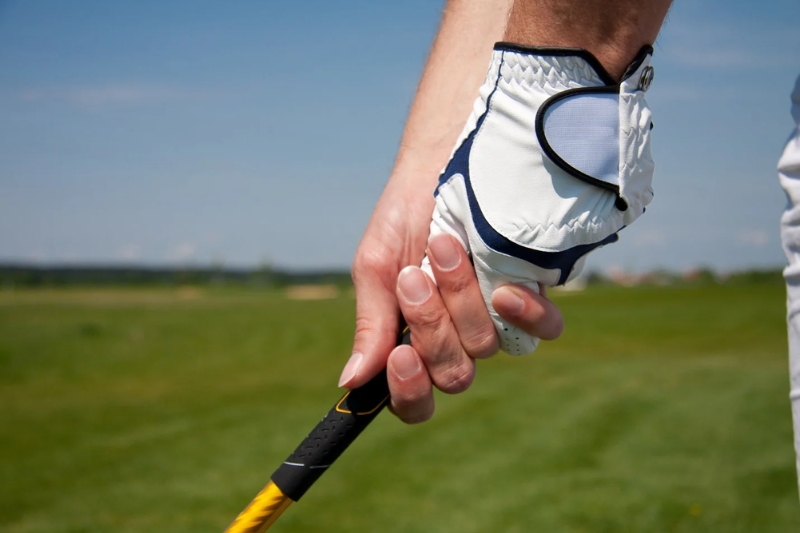
The interlocking grip has gained popularity among right-handed golfers due to its secure hold and balanced feel. This grip style offers a blend of control and power, making it suitable for players of all skill levels.
Placement
To execute the interlocking grip, begin by placing the grip in the palm of your left hand. Your left thumb should extend straight down the grip, guiding the clubface. Position your right hand below the left, interlocking the index finger of your right hand with the middle finger of your left hand. This interlocking technique creates a cohesive connection between both hands, enhancing stability during the swing.
Pressure
As with the Vardon grip, maintaining the right grip pressure is essential. Aim for a firm yet relaxed hold, applying light pressure to avoid tension. A relaxed grip allows for a smoother swing, promoting fluidity and consistency in your shots.
Alignment
Ensure that the clubface remains square to the target line, and align your hands accordingly. Your left hand should be slightly higher than your right, creating a natural angle for an effective swing. Proper alignment sets the stage for accurate shot execution.
Advantages
The interlocking grip offers several benefits that make it a popular choice among golfers:
Balance: The interlocking grip provides a good blend of control and feel, allowing for a more natural swing. This balance helps players maintain a consistent swing path, leading to improved shot accuracy.
Smooth Transition: The interlocking grip facilitates a smooth transition through the swing, minimizing erratic movements. This fluidity contributes to better timing and rhythm, enhancing overall swing quality.
Versatility: Suitable for players of various skill levels, the interlocking grip provides a reliable grip for various shots. Whether you’re hitting a driver off the tee or executing delicate chips around the green, this grip adapts well to different situations.
The Baseball Grip: A More Relaxed and Intuitive Approach for Right-Handers
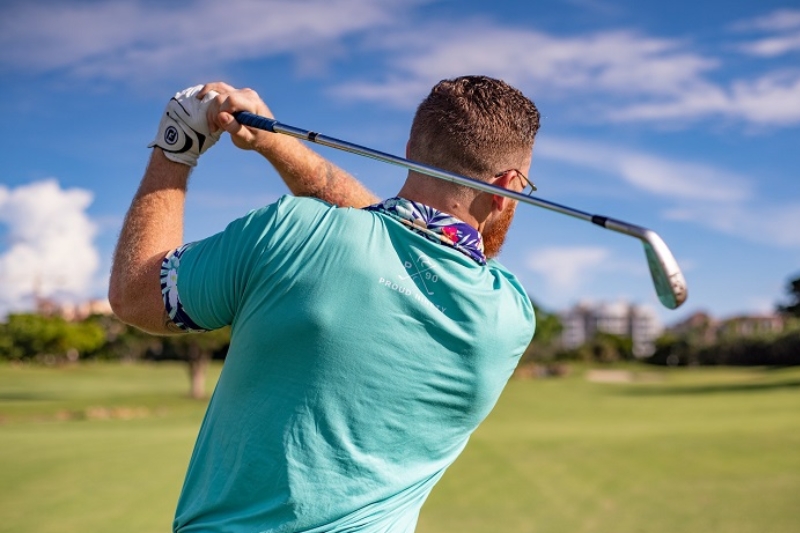
The baseball grip, known for its simplicity, offers a relaxed and intuitive feel, particularly for those who are new to golf or struggle with other grip types. This grip style mimics the natural grip used for holding a baseball bat, making it accessible for beginners.
Placement
To execute the baseball grip, place your left hand on the club’s grip with the thumb pointing straight down the shaft. Your fingers should wrap around the grip comfortably. Next, position your right hand below the left, ensuring that both palms face each other and the thumbs point slightly up toward the target. This side-by-side placement promotes a relaxed grip that encourages a natural swing.
Pressure
Maintaining a relaxed grip is key when using the baseball grip. Allow your hands to move naturally without excessive tension. A relaxed grip reduces strain on your muscles, enabling freer swing mechanics and improved shot execution.
Alignment
As with other grip styles, ensure that the clubface is square to the target line. Keep your hands aligned with the target line, maintaining a neutral position. Proper alignment is essential for achieving consistent ball flight and accuracy.
Advantages
The baseball grip offers several benefits that make it appealing to golfers, especially beginners:
Intuitive: The baseball grip mimics the natural grip used for holding a baseball bat, promoting comfort and ease. This familiarity can help new golfers feel more confident as they learn the game.
Reduced Tension: The relaxed nature of the baseball grip reduces tension, allowing for freer swing mechanics. This lack of tension can lead to smoother swings and improved shot quality.
Promotes Hand-Eye Coordination: The open grip encourages smoother hand-eye coordination, enhancing your swing quality. This aspect is particularly beneficial for beginners learning to connect with the ball consistently.
Grip Pressure: Finding the Balance Between Firmness and Control
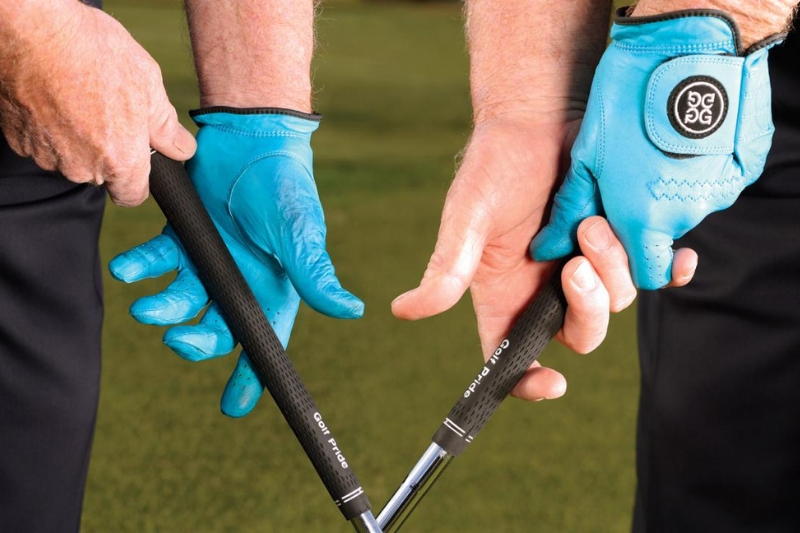
Achieving the right grip pressure is crucial for maximizing both power and control in your swing. The golden rule is to grip the club firmly enough to maintain control but not so tightly that it restricts your swing.
Signs of Overly Tight Grip
Recognizing the signs of an overly tight grip is essential for improving your performance on the course. Some common indicators include:
Tension in Forearms and Hands: Over-tightening the grip can lead to tension in your forearms and hands, inhibiting your ability to swing smoothly. This tension can disrupt your rhythm and timing, negatively impacting your shot execution.
Decreased Clubhead Speed: A tight grip restricts the free flow of the swing, reducing clubhead speed and power. When your grip is too tight, you may struggle to generate the necessary speed for longer shots.
Lack of Control: Ironically, over-tightening actually leads to less control. When your muscles become fatigued and less responsive due to excessive tension, your ability to make precise adjustments during your swing diminishes.
Tips for Finding the Right Pressure
Finding the ideal grip pressure requires practice and self-awareness. Here are some tips to help you achieve the right balance:
Visualize Holding a Bird: As mentioned earlier, imagine holding a small bird in your hand—just enough pressure to keep it from flying away but not enough to squeeze it tight. This visualization can help you gauge the appropriate grip pressure.
Practice with a Tension-Free Grip: Focus on feeling the club in your hands without applying excessive pressure. Spend time practicing swings with a relaxed grip to develop muscle memory for the right amount of pressure.
Listen to Your Body: Pay attention to the sensations in your hands and forearms. If you feel tension, loosen your grip slightly until it feels relaxed. Trusting your body’s feedback can lead to improved swing mechanics.
Positioning Your Hands: Achieving the Correct Alignment for Right-Handed Golf

The position of your hands on the club is equally important as the pressure you apply. Proper alignment ensures your swing path is optimal, leading to consistent ball flight and accuracy.
Hand Position
To achieve the correct hand position, follow these guidelines:
Left Hand: The grip should rest on the palm of your left hand, with your thumbs pointing down the shaft. The left thumb can help act as a guide to keep the clubface square to the target line. Ensure that your fingers wrap comfortably around the grip without excessive tension.
Right Hand: Depending on the grip type, position your right hand below the left with the thumbs pointing toward the target. The right hand should complement the left hand’s grip, creating a unified hold on the club.
Key Points for Alignment
Proper alignment is crucial for achieving consistent results. Here are some key points to consider:
Clubface Square: Keep the clubface square to the target line, ensuring the club is ready to hit the ball straight. A square clubface at impact is essential for achieving desired shot shapes and distances.
Hands Aligned with Target Line: Position your hands so that they are aligned with the target line, giving you a clear path to swing the club. Misalignment can lead to inconsistent shots and increased difficulty in hitting your target.
Left Hand Slightly Higher: The left hand should be slightly higher than the right hand, creating a natural angle for a powerful swing. This slight elevation allows for a more effective transfer of energy during the swing.
The Impact of Grip on Swing Plane: Optimizing Your Right-Handed Swing
The grip significantly influences your swing path, determining the arc and direction of the clubhead as it moves throughout your swing. Understanding the relationship between grip and swing plane is essential for optimizing your performance.
Swing Plane
The swing plane refers to the imaginary path the clubhead travels during your swing, moving from the backswing to the downswing and through impact. An optimal swing plane is critical for achieving consistent ball flight and accuracy.
Grip & Swing Plane Relationship
Your grip can affect your swing plane in various ways:
Strong Grip: A strong grip tends to create a flatter swing plane, potentially causing the ball to curve to the right (for right-handed golfers). This grip position can lead to a more aggressive swing, but it may also increase the risk of hooks if not managed properly.
Weak Grip: A weaker grip, with the right hand positioned too much to the right, tends to create a more upright swing plane. This adjustment can result in a shot curving to the left, making it essential to find the right balance based on your desired shot shape.
Achieving an Optimal Swing Plane
To optimize your swing plane, consider the following strategies:
Experiment with Grip Strength: Adjust your grip pressure to influence the swing plane based on your desired shot. A firmer grip may encourage a flatter swing, while a lighter grip can promote an upright swing.
Work with a Golf Professional: Seek guidance from a golf instructor to fine-tune your grip and swing plane for consistent and accurate shots. Professional coaching can provide valuable insights and personalized feedback to help you improve your technique.
Common Grip Mistakes and How to Avoid Them: A Right-Handed Perspective
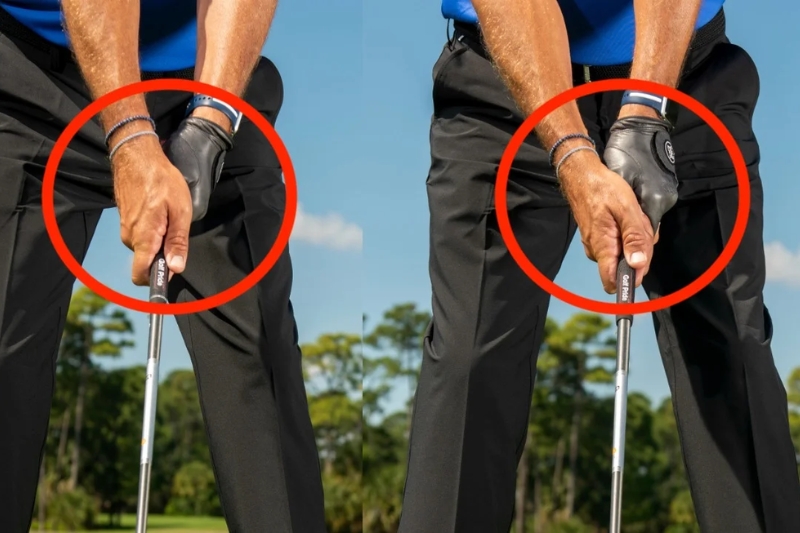
Even experienced golfers can fall victim to common grip mistakes that hinder their performance. Recognizing these errors and implementing corrective measures can lead to significant improvements in your game.
Gripping Too Tightly
One of the most prevalent mistakes golfers make is gripping the club too tightly. Over-tightening the grip restricts your swing and leads to tension, ultimately jeopardizing your swing quality. To avoid this mistake, focus on establishing a firm but relaxed grip. Regularly check in with your hands and forearms during practice sessions to ensure you’re not introducing unnecessary tension.
Weak Grip
A weak grip can lead to an over-the-top swing, causing the ball to slice to the right. Be mindful of hand alignment and ensure the right hand isn’t too much to the right. A strong grip can help mitigate slicing tendencies and promote a more controlled swing path.
Inappropriate Hand Position
Uneven hand alignment can lead to inconsistencies in swing plane and accuracy. Ensure your left hand is slightly higher, and your hands are aligned with the target line. Regularly check your grip position during practice to reinforce proper alignment habits.
Neglecting Thumb Position
The thumb position plays a crucial role in clubface control. Keep your left thumb pointing down the shaft, and your right thumb should point towards the target. Neglecting thumb position can lead to misalignment and reduced shot accuracy.
Ignoring Grip Type Preference
Don’t force yourself to adopt a grip just because it’s popular. Experiment to find the grip type that best suits your hand size and swing characteristics. Everyone’s hands are different, and finding a grip that feels comfortable and natural is essential for long-term success.
Conclusion
In conclusion, mastering the fundamentals of grip is essential for right-handed golfers looking to elevate their game. By understanding the significance of grip types, pressure, hand positioning, and common mistakes, you can unlock your full potential on the course. Remember that experimentation is key—find the grip that feels most comfortable and supportive for your unique style. With consistent practice and dedication, you’ll develop the skills needed to achieve consistent and powerful swings, ultimately leading to improved performance and enjoyment of the game. Embrace the journey of mastering your grip, and watch as your golf game flourishes.

I am the owner of Ricks Golf Shop, a popular destination for golf enthusiasts. My passion for golf began in my teenage years and has only grown over the years. With over 10 years of experience in the golf industry, I offer expert advice and quality products. With a friendly demeanor and extensive knowledge, I ensure every customer leaves happy.
